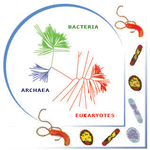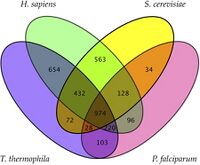Eisen:Research
Home Contact Internal Lab Members Publications Research Overview Current Projects Past Projects Talks News Downloads
Research in the Laboratory of Jonathan A. Eisen
The Eisen Lab research focuses on understanding the genomic basis for the origin of novelty (new functions and processes) in microorganisms. For many years, studies in this area were of limited scope. However, the advent of genome sequencing has allowed one to study the origin of novelty on a more global level. The Eisen lab's main location is in the U. C. Davis Genome Center. Dr. Eisen has appointments in the Section of Evolution and Ecology and the Department of Medical Microbiology at U. C. Davis and an Adjunct Appointment at the Joint Genome Institute, where he runs a small "Phylogenomics" group.
The main overarching focus on the Eisen lab is on the mechanisms by which new functions original and in particular the causes and effects of variation in these mechanisms between taxa. Among our current research topics are:
- Improving phylogenetic coverage of genomes. In order to get a full appreciation of microbial diversity and genomics we needs to understand more about the poorly studied branches in the tree of life. Examples of our work on this include: a past NSF Tree of Life project see here and GEBA (A Genomic Encyclopedia of Bacteria and Archaea) here
- The evolution of intracellular symbioses. One of the simplest ways for organisms to acquire new functions is to engage in symbioses with other species. We use genomic sequencing of a diversity of such symbioses to better understand what the rules are for these symbioses to evolve. Examples of our past projects on this topic include studies of symbionts of the glassy winged sharpshooter here, chemosynthetic symbionts (e.g., here), Wolbachia (wMel genome, BAC from Brugia Wolbachia, letter about Wolbachia classification).
- The functioning of communities of microbes in nature. For many years, we focused on studies of microbes grown in pure culture in the laboratory. Recently, we have shifted much of our focus to using genome sequencing to study microbes directly in their natural habitats. See for example Review, GOS Proteins; GOS Survey; Sargasso metagenomics, Phototroph metagenomics.
- Computational methods for analyzing metagenomic data. We are currently working on multiple projects focusing on designing methods for analyzing metagenomic data. Our work on this includes iSEEM (a collaboration with the labs of Jessica Green and Katherine Pollard [see http://openwetware.org/wiki/ISEEM for more detail]) and a collaboration with Simon Levin and Josh Weitz as part of the DARPA Fundamental laws of Biology program.
- Phylogenomic methods development. Embedded within all our work is the development of computational approaches in which evolutionary reconstructions and genome analyses are combined into a composite phylogenomic approach. (e.g., Eisen1995; Eisen1997, Eisen1998 Eisen2002, Wu2005, EisenWu2002)
- The genomics and evolution of carbon fixation. We use the evolution of carbon fixation as a model for studying the origin and evolution and processes and pathways. Our work includes genomic studies of the reverse TCA cycle (e.g., here, here and here), methylotrophy (here), Carboxydotrophs (e.g., here), plastid evolution and/or the Calvin cycle (e.g., here, here, here, here, and here), and chemosynthetic symbionts (here, here).
Recent News
- Jonathan Eisen is the new Academic Editor in Chief of PLoS Biology. For more detail see my first editorial here.
- Jonathan Eisen's Evolution Textbook has been published. Entitled creatively "Evolution" this is a new textbook jointly authored by Jonathan Eisen, Nick Barton, David Goldstein, Derek Briggs and Nipam Patel. It is published by Cold Spring Harbor Press.
- Recent publications
- For more news see Jonathan Eisen's Work Blog
- For non news see = Jonathan's Davis, CA blog



